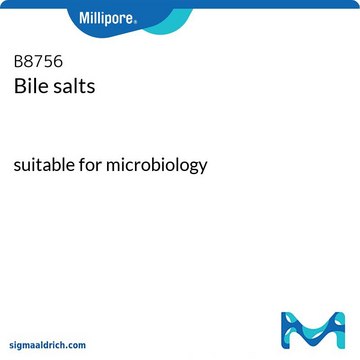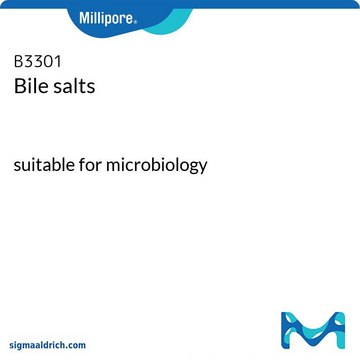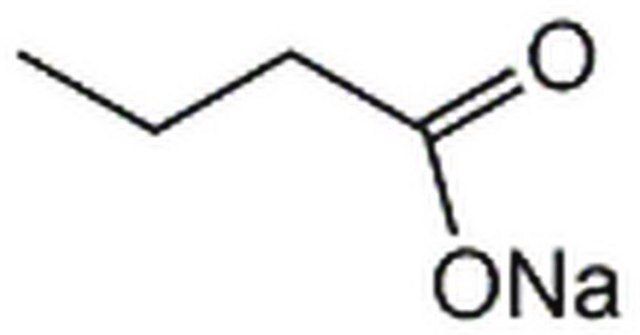B5887
Sodium butyrate
≥98.5% (GC)
Sinonimo/i:
Butyric acid sodium salt
About This Item
Prodotti consigliati
Origine biologica
synthetic (organic)
Livello qualitativo
Saggio
≥98.5% (GC)
Forma fisica
powder
Condizioni di stoccaggio
(Tightly closed. Dry.
Keep in a dry place. )
tecniche
DNA amplification: suitable
cell based assay: suitable
inhibition assay: suitable
Colore
white
Punto di fusione
250-253 °C (lit.)
Solubilità
water: 100 mg/mL, clear to slightly hazy, colorless
Cationi in tracce
Na: 19.8-22.0% (anhydrous)
Compatibilità
suitable for DNA precipitation
applicazioni
cell analysis
life science and biopharma
lipidomics
Temperatura di conservazione
room temp
Stringa SMILE
[Na+].CCCC([O-])=O
InChI
1S/C4H8O2.Na/c1-2-3-4(5)6;/h2-3H2,1H3,(H,5,6);/q;+1/p-1
MFBOGIVSZKQAPD-UHFFFAOYSA-M
Informazioni sul gene
mouse ... ENSMUSG00000061062(15181)
Cerchi prodotti simili? Visita Guida al confronto tra prodotti
Applicazioni
- as a component in homogenization and immunoprecipitation buffer for HDAC inhibition in fly embryos and insect s2 cells.
- as histone deacetylase inhibitor in breast cancer cell line MDA-MB-231, analysed by cell viability assay and viral replication assay.
- to enhance the production of recombinant tissue-plasminogen activator (t-PA) in Chinese hamster ovary (CHO) cells in a bioreactor.
Azioni biochim/fisiol
Avvertenza
Altre note
Prodotti correlati
Avvertenze
Warning
Indicazioni di pericolo
Consigli di prudenza
Classi di pericolo
Acute Tox. 4 Oral - Eye Irrit. 2 - Skin Irrit. 2
Codice della classe di stoccaggio
11 - Combustible Solids
Classe di pericolosità dell'acqua (WGK)
WGK 1
Punto d’infiammabilità (°F)
Not applicable
Punto d’infiammabilità (°C)
Not applicable
Dispositivi di protezione individuale
dust mask type N95 (US), Eyeshields, Gloves
Scegli una delle versioni più recenti:
Possiedi già questo prodotto?
I documenti relativi ai prodotti acquistati recentemente sono disponibili nell’Archivio dei documenti.
I clienti hanno visto anche
Articoli
Naive pluripotent stem cells are located within the epiblast of mature blastocysts. These primitive “ground-state” cells may be cultured in vitro using specialized media and small molecule inhibitors.
Epigenetic modifications are thought to occur through two key interconnected processes—DNA methylation and the covalent modification of histones.
Il team dei nostri ricercatori vanta grande esperienza in tutte le aree della ricerca quali Life Science, scienza dei materiali, sintesi chimica, cromatografia, discipline analitiche, ecc..
Contatta l'Assistenza Tecnica.










